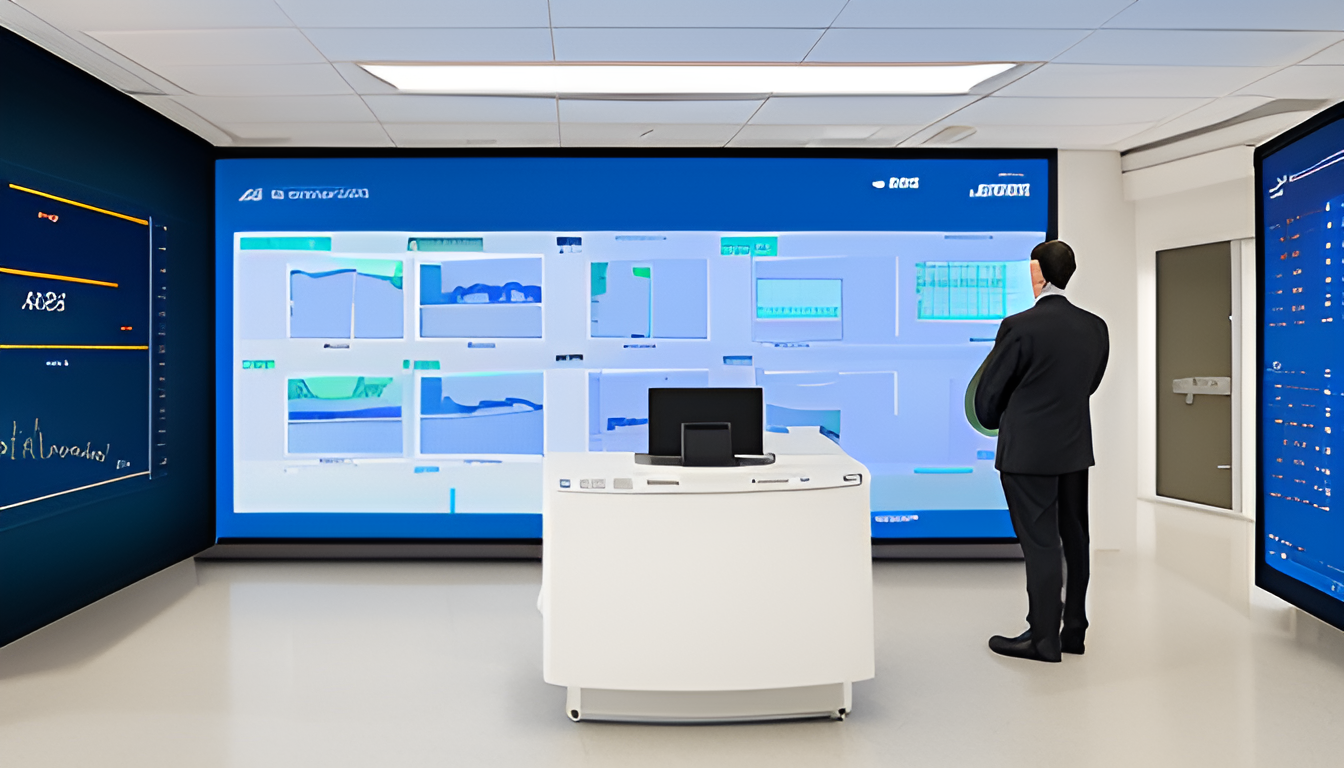Revolutionizing Healthcare with AI: Diagnosis and Treatment

The world of healthcare is undergoing a seismic shift, propelled by the integration of artificial intelligence (AI). Imagine a future where doctors are equipped with intelligent systems that not only assist in diagnosing ailments but also tailor treatments to individual patients. This is not just a dream; it’s happening right now! AI is transforming healthcare by enhancing diagnostic accuracy and personalizing treatment plans, ultimately leading to better patient outcomes.
At the heart of this revolution is the ability of AI to analyze vast amounts of medical data swiftly and accurately. With machine learning algorithms, healthcare professionals can identify diseases at their earliest stages, which is crucial for effective treatment. Think of it this way: just as a skilled detective piecing together clues to solve a mystery, AI sifts through complex data to reveal hidden patterns that can indicate health issues long before they become critical.
But how does this all work? AI technologies are making waves in various areas, including medical imaging. Advanced algorithms assist radiologists by enhancing image analysis, making it easier to detect abnormalities in X-rays, MRIs, and CT scans. This not only speeds up the diagnostic process but also improves precision. For instance, consider the role of deep learning techniques like convolutional neural networks (CNNs), which are designed to recognize intricate patterns in images, akin to how our brain processes visual information.
Furthermore, AI’s impact extends beyond diagnosis. It’s also reshaping treatment plans, allowing for a more personalized approach to medicine. By analyzing genetic and clinical data, AI can recommend therapies that are specifically tailored to individual patients. This means fewer side effects and more effective treatments, much like having a bespoke suit made just for you—perfectly fitted to your unique needs.
As we embrace these advancements, it’s essential to remain aware of the challenges that come with them. Ethical considerations, data privacy, and the potential for bias in AI algorithms must be addressed to ensure that this technology serves all patients equitably. In conclusion, the integration of AI in healthcare promises a future where diagnosis and treatment are not only more accurate but also more personalized, paving the way for a healthier world.
The Role of AI in Diagnosis
Artificial Intelligence (AI) is becoming a game-changer in the field of healthcare, particularly in the realm of diagnosis. Imagine a world where diseases are identified not just by human intuition but through the power of advanced algorithms analyzing vast amounts of medical data in seconds. This is not just a futuristic dream; it’s happening right now! AI technologies are increasingly being employed to enhance diagnostic accuracy, leading to timely interventions and improved patient outcomes.
One of the most exciting aspects of AI in diagnosis is its ability to analyze data from various sources, including medical histories, lab results, and even genetic information. By utilizing machine learning algorithms, these systems can recognize patterns that may not be immediately apparent to human practitioners. This means that conditions can be detected at much earlier stages, significantly increasing the chances of successful treatment.
For instance, consider a scenario where a patient visits a doctor with vague symptoms. An AI system can quickly sift through thousands of similar cases and identify potential diagnoses that might have been overlooked. This capability not only aids in making more accurate diagnoses but also helps in prioritizing cases based on urgency.
Furthermore, AI’s role doesn’t stop at just identifying diseases. It also provides insights into treatment options tailored to the specific needs of the patient. By analyzing data from past cases and current medical literature, AI can suggest personalized treatment plans that maximize effectiveness while minimizing side effects. This is what we call precision medicine, and it’s revolutionizing how we approach healthcare.
However, as we embrace these innovations, it’s crucial to remember that AI is a tool designed to assist healthcare professionals, not replace them. The human touch in patient care remains irreplaceable, and AI should be viewed as a partner in the diagnostic process. In the end, the goal is to create a healthcare system that leverages the best of both worlds—human expertise combined with the efficiency and accuracy of AI.
AI in Medical Imaging
Artificial intelligence is truly revolutionizing the field of medical imaging, transforming the way we detect and diagnose diseases. By leveraging advanced algorithms, AI enhances the image analysis process, enabling healthcare professionals to identify abnormalities in images such as X-rays, MRIs, and CT scans with remarkable precision and speed. Imagine having a virtual assistant that tirelessly analyzes thousands of images in mere seconds, allowing radiologists to focus on patient care rather than being bogged down by the sheer volume of data.
One of the most significant advancements in this area is the use of deep learning techniques. These techniques, particularly convolutional neural networks (CNNs), are designed to mimic the way the human brain processes visual information. By training these networks on vast datasets of medical images, AI can learn to recognize patterns that may be invisible to the naked eye. This not only speeds up the diagnostic process but also increases the accuracy of the findings, ultimately leading to better patient outcomes.
Furthermore, AI-driven image segmentation techniques are game-changers in identifying specific areas of interest within medical scans. For instance, when a radiologist examines a CT scan for signs of tumors, AI can assist by isolating the tumor’s location, size, and shape, providing critical information that aids in treatment planning. The ability to pinpoint these details accurately can mean the difference between a successful intervention and a missed opportunity.
Moreover, the integration of predictive analytics in imaging is taking the capabilities of AI even further. By analyzing historical imaging data, AI models can forecast disease progression, helping doctors tailor interventions that are not only timely but also more effective. This predictive power empowers healthcare providers to make informed decisions, ensuring that patients receive the right care at the right time.
In summary, AI in medical imaging is not just about enhancing the accuracy of diagnoses; it’s about creating a more efficient, effective, and patient-centered healthcare experience. As we continue to harness the power of AI, the future of medical imaging looks brighter than ever.
Deep Learning Techniques
Deep learning techniques are at the forefront of revolutionizing medical imaging, acting like the brain of a computer that learns from vast amounts of data. Imagine teaching a child to recognize different animals by showing them thousands of pictures; similarly, deep learning algorithms, particularly Convolutional Neural Networks (CNNs), are trained on massive datasets of medical images to identify patterns and anomalies. This process not only enhances the accuracy of diagnoses but also accelerates the time it takes for healthcare professionals to make critical decisions.
One of the standout features of CNNs is their ability to automatically extract features from images without requiring manual intervention. This is akin to having a super-smart assistant who can sift through mountains of paperwork and highlight the most important details for you. For instance, in the case of X-rays or MRIs, these algorithms can pinpoint areas of concern, such as tumors or fractures, with remarkable precision.
Furthermore, the application of deep learning in medical imaging extends beyond mere detection. Techniques such as image segmentation allow AI to isolate specific regions within an image, which is crucial for accurately identifying the extent of a disease. By focusing on these targeted areas, healthcare providers can devise more effective treatment plans tailored to the patient’s needs. This fine-tuned approach not only enhances diagnostic capabilities but also contributes to better patient outcomes.
Moreover, the integration of predictive analytics into deep learning models can forecast disease progression based on historical imaging data. Imagine being able to predict how a condition might evolve over time, allowing for proactive interventions rather than reactive treatments. This predictive power is a game-changer in clinical settings, enabling healthcare providers to tailor their strategies and improve patient management.
In summary, deep learning techniques are reshaping the landscape of medical imaging. By harnessing the capabilities of CNNs and other advanced algorithms, healthcare professionals are equipped with tools that enhance diagnostic accuracy, streamline workflows, and ultimately lead to improved patient care. As we continue to explore the potential of AI in healthcare, the future looks promising, filled with opportunities for innovation and better health outcomes.
Image Segmentation
Image segmentation is a groundbreaking technique that allows healthcare professionals to pinpoint specific areas of interest within medical scans. Imagine trying to find a needle in a haystack; segmentation simplifies this process by breaking down complex images into manageable parts. By isolating regions of interest, such as tumors or lesions, AI-driven segmentation enhances the accuracy of diagnoses and treatment plans.
One of the most significant advantages of image segmentation is its ability to provide detailed insights into the nature of a disease. For instance, when analyzing an MRI scan, segmentation can help differentiate between healthy tissue and pathological changes. This capability not only aids in precise localization but also informs the treatment approach. With the right segmentation, a doctor can tailor interventions that target the specific areas affected by disease, leading to more effective outcomes.
Moreover, segmentation techniques can be categorized into various approaches, including:
- Thresholding: This method segments images based on intensity levels, allowing for straightforward differentiation between structures.
- Edge Detection: By identifying boundaries within images, edge detection highlights the contours of organs or tumors.
- Region-Based Segmentation: This technique groups neighboring pixels with similar properties, creating a more cohesive view of the area of interest.
As AI continues to evolve, so do the methods of image segmentation. Advanced algorithms now utilize deep learning to enhance segmentation accuracy further. For example, convolutional neural networks (CNNs) have shown remarkable success in distinguishing between subtle differences in medical images. This level of precision is crucial in fields like oncology, where early detection can significantly impact patient survival rates.
In summary, image segmentation is not just a technical advancement; it represents a paradigm shift in how we approach medical imaging. By leveraging AI to enhance segmentation, healthcare providers can ensure that patients receive the most accurate diagnoses and personalized treatment plans possible.
Predictive Analytics in Imaging
Predictive analytics in imaging is a game-changer in the healthcare landscape, offering a glimpse into the future of patient care. By leveraging advanced algorithms, healthcare providers can forecast disease progression based on imaging data, which is nothing short of revolutionary. Imagine being able to predict the trajectory of a patient’s illness before it even manifests fully—this is the power of predictive analytics.
At its core, predictive analytics utilizes historical data and sophisticated modeling techniques to identify patterns and trends. For instance, AI algorithms can analyze past imaging results alongside patient demographics and clinical histories to generate insights about potential health risks. This proactive approach allows healthcare professionals to develop tailored intervention strategies, ultimately leading to improved patient outcomes.
Consider a scenario where a radiologist reviews a series of MRI scans. By applying predictive analytics, the system can highlight areas of concern and suggest potential diagnoses based on similar cases. This not only enhances the radiologist’s efficiency but also increases the likelihood of early detection of serious conditions, such as tumors or degenerative diseases.
Furthermore, predictive analytics can play a crucial role in patient management by:
- Identifying high-risk patients who may require closer monitoring.
- Optimizing treatment plans based on predicted responses to therapies.
- Facilitating timely interventions that can significantly alter disease outcomes.
As we continue to harness the power of predictive analytics, the healthcare industry stands on the brink of a transformation that will not only enhance diagnostic accuracy but also empower patients. The integration of these advanced technologies into imaging practices is paving the way for a future where healthcare is not just reactive but also predictive and personalized.
Natural Language Processing in Healthcare
Natural Language Processing, or NLP, is rapidly changing the landscape of healthcare by transforming how we analyze and utilize data. Imagine having a digital assistant that can sift through mountains of clinical notes, research articles, and patient records in the blink of an eye. That’s the power of NLP! By leveraging algorithms that understand and interpret human language, NLP tools can extract valuable insights that were once buried in unstructured data.
One of the most exciting applications of NLP in healthcare is its ability to enhance patient care. For instance, NLP can summarize patient histories, identify trends in symptoms, and even flag potential health risks. This means that healthcare providers can make more informed decisions faster, ultimately leading to better patient outcomes. But how does it work? Here are a few key functions of NLP in the healthcare sector:
- Data Extraction: NLP can pull relevant information from clinical notes, enabling healthcare professionals to focus on what truly matters.
- Sentiment Analysis: Understanding patient sentiment through their notes can help providers gauge emotional well-being and tailor care accordingly.
- Clinical Decision Support: By analyzing unstructured data, NLP can provide recommendations that assist doctors in making timely decisions.
Moreover, NLP is instrumental in research, where it helps in mining vast databases of medical literature to discover new treatments and therapies. This capability allows researchers to stay ahead of the curve, ensuring that they are aware of the latest findings and advancements. However, with great power comes great responsibility. The integration of NLP into healthcare also raises questions about data privacy and the need for robust security measures to protect sensitive patient information.
In conclusion, the role of NLP in healthcare is not just a trend; it’s a revolution. By harnessing the power of language and data, NLP is paving the way for more efficient, personalized, and effective healthcare solutions. As we continue to explore this exciting frontier, the potential for improved patient care and operational efficiency is limitless!
AI-Driven Treatment Plans
Artificial Intelligence (AI) is not just a buzzword; it’s a game-changer in the realm of healthcare, particularly when it comes to personalizing treatment plans. Imagine walking into a doctor’s office and knowing that the treatment you receive has been tailored specifically to your unique health profile. Sounds like science fiction? Well, it’s becoming a reality! AI algorithms analyze vast amounts of patient data, including genetic information, medical history, and lifestyle factors, to recommend the most effective therapies. This personalized approach not only boosts the chances of recovery but also minimizes the risk of side effects.
One of the most exciting aspects of AI-driven treatment plans is their ability to adapt over time. For instance, as a patient undergoes treatment, AI systems continuously monitor their progress and can adjust the treatment plan in real-time. This dynamic capability ensures that patients receive the most effective care possible, tailored to their evolving needs.
Furthermore, AI can help in identifying patterns that even experienced doctors might miss. By analyzing data from thousands of similar cases, AI can suggest treatment options that have proven successful for others with similar conditions. This is particularly useful in complex cases where standard treatment protocols may not be effective.
To illustrate the impact of AI in treatment planning, consider the following table that showcases the benefits of AI-driven treatment plans:
| Benefit | Description |
|---|---|
| Personalization | Treatment plans are customized based on individual patient data. |
| Real-time Adaptation | Plans can be adjusted based on patient progress and feedback. |
| Data-Driven Insights | AI analyzes large datasets to recommend effective treatments. |
| Improved Outcomes | Higher chances of successful treatment and reduced side effects. |
In summary, AI-driven treatment plans are revolutionizing the way healthcare is delivered. By leveraging technology, healthcare providers can offer a level of precision and customization that was previously unimaginable. As we continue to explore the potential of AI in medicine, the future looks bright for patient care!
Personalized Medicine
Imagine a world where medicine is tailored specifically for you, just like a custom-made suit. is not just a dream; it’s rapidly becoming a reality, thanks to the integration of artificial intelligence in healthcare. By analyzing a patient’s genetic makeup alongside their clinical history, AI can help identify the most effective treatments tailored to individual needs. This approach is shifting the paradigm from a one-size-fits-all method to a more nuanced, individualized strategy.
At its core, personalized medicine leverages big data and advanced algorithms to sift through vast amounts of information. For instance, AI can analyze genetic data to pinpoint mutations that may affect how a patient responds to certain medications. This means doctors can prescribe treatments that are more likely to work, minimizing the trial-and-error approach that often leads to frustration and delays in recovery.
Consider the following key aspects of personalized medicine:
- Genetic Profiling: By examining a patient’s DNA, healthcare providers can predict how they will respond to specific treatments.
- Targeted Therapies: AI can identify therapies that target the underlying mechanisms of diseases, especially in conditions like cancer.
- Reduced Side Effects: With tailored treatments, patients are less likely to experience adverse reactions, leading to a more comfortable healing process.
Moreover, the data collected from various sources, including wearable devices and electronic health records, can enhance the personalization process. AI continuously learns from this data, refining its recommendations and improving patient outcomes over time. It’s like having a personal health assistant that never sleeps, always working to find the best solutions for your unique health profile.
In summary, personalized medicine represents a significant leap forward in healthcare. By harnessing the power of AI, we can move towards a future where treatments are not only more effective but also safer, offering hope for better health outcomes for everyone.
Robotic Surgery
Robotic surgery is taking the medical world by storm, offering a level of precision and control that was once thought impossible. Imagine a surgeon working with a robot that can make incisions smaller than a grain of rice, minimizing damage to surrounding tissues. This innovation is not just about fancy technology; it’s about enhancing patient outcomes and revolutionizing surgical procedures.
At the heart of robotic surgery is the da Vinci Surgical System, a state-of-the-art platform that allows surgeons to perform complex procedures through tiny incisions. This system combines advanced robotic arms with high-definition 3D visualization, enabling surgeons to operate with unmatched accuracy. With the ability to scale and filter hand movements, the robot translates the surgeon’s actions into precise movements inside the patient’s body.
Some of the key benefits of robotic surgery include:
- Minimally Invasive: Smaller incisions lead to less pain and quicker recovery times.
- Enhanced Precision: Robotic tools can maneuver in ways that the human hand cannot, reducing the risk of complications.
- Shorter Hospital Stays: Patients often leave the hospital sooner, allowing them to return to their daily lives faster.
However, it’s essential to note that robotic surgery is not without its challenges. The technology requires extensive training and experience, and the cost of robotic systems can be quite high. Nevertheless, the potential benefits often outweigh these concerns, making robotic surgery a valuable tool in modern medicine.
In conclusion, as robotic surgery continues to evolve, it holds the promise of making surgical procedures safer and more effective. With ongoing advancements, we can expect even greater innovations that will further transform the landscape of healthcare.

Challenges and Ethical Considerations
As we embrace the incredible potential of artificial intelligence in healthcare, it’s crucial to address the that come along with this technological revolution. While AI can significantly enhance diagnosis and treatment, it also raises important questions about data privacy, algorithmic bias, and the necessity of maintaining human oversight.
One of the most pressing issues is data privacy and security. With AI systems processing vast amounts of sensitive health information, ensuring that patient data remains confidential is paramount. Healthcare providers must implement robust security measures to protect against data breaches, which can lead to devastating consequences for patients. For instance, a recent study highlighted that nearly 70% of patients are concerned about how their health data is used. This apprehension can hinder the adoption of AI technologies unless trust is established.
Moreover, bias in AI algorithms poses a significant risk. If the data used to train AI systems is not representative of diverse populations, it can lead to unequal healthcare outcomes. For example, a biased algorithm might misdiagnose conditions more frequently in certain demographic groups, exacerbating existing health disparities. To combat this, developers must prioritize fairness and inclusivity in their algorithms, ensuring that they are trained on diverse datasets that reflect the population at large.
Additionally, the reliance on AI raises the question of human oversight. While AI can process information faster and more accurately than humans, decisions regarding patient care should not be left solely to machines. The medical community must strike a balance between leveraging AI’s capabilities and maintaining the critical human element in healthcare. After all, compassion and understanding are irreplaceable components of patient care.
In summary, while AI presents exciting opportunities for revolutionizing healthcare, it is essential to navigate the associated challenges carefully. By addressing data privacy, combating bias, and ensuring human oversight, we can harness the full potential of AI while safeguarding the principles of ethical healthcare.
Data Privacy and Security
In the rapidly evolving landscape of healthcare, have emerged as critical concerns, especially with the integration of artificial intelligence (AI). As healthcare providers increasingly rely on AI to analyze vast amounts of patient data, ensuring that this sensitive information remains secure is paramount. Imagine your medical records being exposed to unauthorized access; it’s a nightmare scenario that could compromise not only your privacy but also your trust in the healthcare system.
To address these challenges, healthcare organizations must implement robust security measures. Here are some essential strategies:
- Encryption: Encrypting patient data ensures that even if it is intercepted, it remains unreadable to unauthorized users.
- Access Controls: Limiting access to sensitive information to only those who need it can significantly reduce the risk of data breaches.
- Regular Audits: Conducting periodic security audits helps identify vulnerabilities and strengthen defenses.
Moreover, compliance with regulations such as the Health Insurance Portability and Accountability Act (HIPAA) in the United States is crucial. These regulations set the standards for protecting patient information and require healthcare entities to implement safeguards that ensure the confidentiality, integrity, and availability of sensitive data.
As AI continues to advance, the challenge of maintaining data privacy will only grow. Healthcare organizations must stay ahead of potential threats by adopting a proactive approach that includes continuous training for staff on data security practices and the implementation of cutting-edge technologies, such as blockchain, which can enhance data security through decentralized storage.
Ultimately, while AI holds tremendous potential to revolutionize healthcare, it is vital that we prioritize to protect patients and maintain trust in the healthcare system. Balancing innovation with ethical considerations will be key to harnessing the full benefits of AI in healthcare.
Bias in AI Algorithms
The integration of artificial intelligence in healthcare has brought about remarkable advancements, but it also raises significant concerns regarding . These biases can stem from various sources, including the data used to train these systems, which may not accurately represent diverse populations. For instance, if an AI model is primarily trained on data from one demographic, it may struggle to make accurate predictions for individuals outside that group. This lack of representation can lead to unequal healthcare outcomes, reinforcing existing disparities.
Moreover, biases can manifest in numerous ways, such as:
- Data Selection Bias: When the data collected is not comprehensive, it can skew the results of AI algorithms.
- Labeling Bias: Human error in labeling training data can introduce inaccuracies that affect the model’s performance.
- Algorithmic Bias: The inherent design of algorithms can favor certain groups over others, leading to unfair treatment recommendations.
Addressing these biases is crucial to ensure that AI-driven healthcare solutions are equitable and effective. Developers and healthcare professionals must work together to implement strategies that promote fairness, such as:
- Utilizing diverse datasets that reflect various populations.
- Regularly auditing algorithms for bias and adjusting them as necessary.
- Incorporating feedback from a wide range of stakeholders, including patients and healthcare providers.
Ultimately, the goal is to create AI systems that not only enhance diagnostic and treatment processes but also uphold the principles of equity and justice in healthcare. By acknowledging and tackling bias in AI algorithms, we can pave the way for a more inclusive and effective healthcare landscape.
Frequently Asked Questions
- How is AI improving diagnosis in healthcare?
AI is transforming diagnosis by utilizing machine learning algorithms to analyze vast amounts of medical data. This helps in identifying diseases at their earliest stages, which can lead to better patient outcomes and more effective treatments.
- What role does AI play in medical imaging?
AI enhances medical imaging by assisting radiologists in detecting abnormalities in X-rays, MRIs, and CT scans. With advanced algorithms, AI can analyze images with greater precision and speed, improving the accuracy of diagnoses.
- What is personalized medicine and how does AI contribute to it?
Personalized medicine tailors treatments to individual patients based on their genetic and clinical data. AI analyzes this information to recommend the most effective therapies, minimizing side effects and optimizing patient care.
- What are the ethical considerations of using AI in healthcare?
While AI offers significant benefits, it raises ethical concerns such as data privacy, algorithmic bias, and the need for human oversight. It’s crucial to ensure that AI systems are developed and implemented responsibly to protect patient rights.
- How does AI handle data privacy and security?
AI systems must implement stringent measures to protect sensitive health information. This includes encryption, secure data storage, and compliance with regulations to ensure that patient data remains confidential and secure.
- Can AI algorithms be biased, and how can this impact healthcare?
Yes, AI algorithms can exhibit bias, which may lead to unequal healthcare outcomes. It’s essential to develop fair algorithms and continuously monitor their performance to mitigate bias and ensure equitable treatment for all patients.













